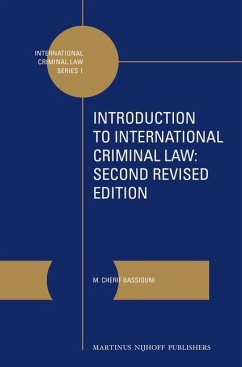M. Cherif Bassiouni
Introduction to International Criminal Law
M. Cherif Bassiouni
Introduction to International Criminal Law
- Broschiertes Buch
- Merkliste
- Auf die Merkliste
- Bewerten Bewerten
- Teilen
- Produkt teilen
- Produkterinnerung
- Produkterinnerung
Written by one of the world's pioneers and leading authorities on international criminal law, this text book covers the history, nature, and sources of international criminal law; the ratione personae; ratione materiae--sources of substantive international criminal law; the indirect enforcement system; the direct enforcement system; the function of the international criminal court; rules of procedure and evidence applicable to international criminal proceedings; and the future of international criminal law.
This textbook is fully updated, comprehensive, easy to read, and ideally suited for…mehr
Andere Kunden interessierten sich auch für
![The Theory and Practice of International Criminal Law The Theory and Practice of International Criminal Law]() Michael ScharfThe Theory and Practice of International Criminal Law260,99 €
Michael ScharfThe Theory and Practice of International Criminal Law260,99 €![International Criminal Law (3 Vols) International Criminal Law (3 Vols)]() M. Ch. BassiouniInternational Criminal Law (3 Vols)764,99 €
M. Ch. BassiouniInternational Criminal Law (3 Vols)764,99 €![International Criminal Law International Criminal Law]() International Criminal Law277,99 €
International Criminal Law277,99 €![Critical Approaches to International Criminal Law Critical Approaches to International Criminal Law]() Critical Approaches to International Criminal Law79,99 €
Critical Approaches to International Criminal Law79,99 €![International Criminal Law International Criminal Law]() Ilias BantekasInternational Criminal Law84,99 €
Ilias BantekasInternational Criminal Law84,99 €![International and European Criminal Law International and European Criminal Law]() Helmut SatzgerInternational and European Criminal Law77,99 €
Helmut SatzgerInternational and European Criminal Law77,99 €![International and European Criminal Law International and European Criminal Law]() Helmut SatzgerInternational and European Criminal Law158,99 €
Helmut SatzgerInternational and European Criminal Law158,99 €-
-
-
Written by one of the world's pioneers and leading authorities on international criminal law, this text book covers the history, nature, and sources of international criminal law; the ratione personae; ratione materiae--sources of substantive international criminal law; the indirect enforcement system; the direct enforcement system; the function of the international criminal court; rules of procedure and evidence applicable to international criminal proceedings; and the future of international criminal law.
This textbook is fully updated, comprehensive, easy to read, and ideally suited for classroom use.
Also available as hardback: isbn 9789004264977
Hinweis: Dieser Artikel kann nur an eine deutsche Lieferadresse ausgeliefert werden.
This textbook is fully updated, comprehensive, easy to read, and ideally suited for classroom use.
Also available as hardback: isbn 9789004264977
Hinweis: Dieser Artikel kann nur an eine deutsche Lieferadresse ausgeliefert werden.
Produktdetails
- Produktdetails
- International Criminal Law Series Vol.1
- Verlag: Brill / Brill Nijhoff
- 2., NED
- Seitenzahl: 1260
- Erscheinungstermin: 30. November 2012
- Englisch
- Abmessung: 236mm x 154mm x 60mm
- Gewicht: 1646g
- ISBN-13: 9789004186446
- ISBN-10: 9004186441
- Artikelnr.: 35902327
- Herstellerkennzeichnung
- Libri GmbH
- Europaallee 1
- 36244 Bad Hersfeld
- 06621 890
- International Criminal Law Series Vol.1
- Verlag: Brill / Brill Nijhoff
- 2., NED
- Seitenzahl: 1260
- Erscheinungstermin: 30. November 2012
- Englisch
- Abmessung: 236mm x 154mm x 60mm
- Gewicht: 1646g
- ISBN-13: 9789004186446
- ISBN-10: 9004186441
- Artikelnr.: 35902327
- Herstellerkennzeichnung
- Libri GmbH
- Europaallee 1
- 36244 Bad Hersfeld
- 06621 890
M. Cherif Bassiouni is Emeritus Professor of Law and President Emeritus of the International Human Rights Law Institute at DePaul University College of Law. He is President of the International Institute of Higher Studies in Criminal Sciences, which he helped found in 1972, and Honorary President of the International Association of Penal Law, of which he was President between 1989 and 2004. Professor Bassiouni has led commissions of inquiry to investigate conflicts in Afghanistan, Bahrain, Iraq, Libya and the Former Yugoslavia. He has also been appointed to numerous United Nations posts, including as the Independent Expert to the Human Rights Council on victims' rights. In 1999, he was nominated for the Nobel Peace Prize for his work establishing the International Criminal Court. Professor Bassiouni is the editor of 45 books, and the author of 23 books and 242 book chapters, journal articles and other legal publications on International Criminal Law, Comparative Criminal Law, Human Rights and U.S. Criminal Law. His writings on have been widely cited by leading international and national tribunals, including the International Court of Justice, the International Criminal Tribunal for the Former Yugoslavia, the International Criminal Tribunal for Rwanda, the Extraordinary Chambers in the Courts of Cambodia, the European Court of Human Rights, the U.S. Supreme Court and State Supreme Courts, the U.K. House of Lords, the High Court of Australia, the Supreme Court of Canada, the Supreme Court of Israel and the Constitutional Court of South Africa.
Chapter I.The Discipline of International Criminal Law
Section 1. The Sources of International Criminal Law; Section 2. The Peculiarities of ICL Enforcement Regimes; Section 3. The Policies and Values of ICL and their Systemic Development; Section 4. The Changing Nature of International Law and Relations and Their Impact on ICL; Section 5. Conclusion;
Chapter II. The Subjects of International Criminal Law: Ratione Personae
Section 1. Introduction; Section 2. Doctrinal Considerations; Section 3. International Criminal Responsibility of Individuals; Section 4. Criminal Responsibility of Heads of State and Other Persons Benefiting from International Immunities; Section 5. International Criminal Responsibility of Groups and Organizations; Section 6. International Criminal Responsibility of States; Section 7. The Victim as a Subject of ICL; Section 8. Conclusion;
Chapter III. International Crimes: Ratione Materiae
Section 1. Introduction; Section 2. Codification of ICL; Section 3. Criteria for International Criminalization; Section 4. The Penal Characteristics of ICL Conventions; Section 5. The Hierarchy of International Crimes; Section 6. The General Categories of International Crimes; Section 7. Evolution of the Process of International Criminalization; Section 8. Jus Cogens International Crimes; Section 9. The Principles of Legality and the Ratione Materiae of ICL; Section 10. Conclusion; Appendix: ICL Conventions and Related Materials;
Chapter IV. Principles of Criminal Responsibility: The General Part
Section 1. Introduction; Section 2. General Considerations; Section 3. National Legal Standards and Their Relevance to ICL; Section 4. Some Problems in Identifying the General Part from the Charter to the Rome Statute; Section 5. Some Specific Problems;
Section 6. The Application of the General Part by the IMT, IMTFE and in Other Proceedings: A Historical Analysis; Section 7. The Jurisprudence of the ICTY, the ICTR, and the ICC; Section 8. Command Responsibility: Policy Considerations; Section 9. Joint Criminal Enterprise; Section 10. Defenses and Exoneration; Section 11. ICL Penalties and Sentencing; Section 12. Conclusion;
Chapter V. The "Indirect Enforcement System:" Modalities of International Cooperation in Penal Matters
Section 1. Introduction; Section 2. The Maxim Aut Dedere Aut Judicare;
Section 3. The Modalities of "International Cooperation in Penal Matters"; Section 4. Assessing the "Indirect Enforcement System"; Section 5. Conclusion;
Chapter VI. The "Direct Enforcement System:" History of International Criminal Investigations and Prosecutions
Section 1. Introduction; Section 2. History of International Criminal Investigations and Prosecutions: From Versailles to Rome, 1919-1998; Section 3. Establishing an International Criminal Court 1937-1994; Section 4. Changing Times: 1989-1998; Section 5. Recent Developments 1998-2011; Section 6. Conclusion;
Chapter VII. The International Criminal Court: A Hybrid "Direct Enforcement System"
Section 1. The Need for an ICC; Section 2. The Characteristics of the ICC; Section 3. Applicable Law; Section 4. The Jurisdiction of the ICC; Section 5. Elements of Criminal Responsibility: The General Part; Section 6. Invoking the Jurisdiction of the Court; Section 7. The Court's Exercise of Jurisdiction; Section 8. Penalties and Sentencing; Section 9. Victim Reparation; Section 10. Enforcement Modalities, Surrender, and Judicial Assistance; Section 11. Exceptions to the Obligation to Cooperate; Section 12. The Organization and Operation of the Court; Section 13. Relationship of the ICC with the United Nations; Section 14. Amending the Statute; Section 15. The Operation of the Court; Section 16. Assembly of State Parties; Section 17. National Implementing Legislation; Section 18. Summary of the ICC's Work; Section 19. Conclusion;
Chapter VIII. Mixed Models of International Criminal Justice
Section 1. Introduction; Section 2. Kosovo; Section 3. Bosnia and Herzegovina; Section 4. Sierra Leone; Section 5. Timor-Leste; Section 6. Cambodia; Section 7. Lebanon; Section 8. Conclusion;
Chapter IX. The "Procedural Part" of ICL: Procedural and Evidentiary Norms Applicable to International Criminal Proceedings
Section 1. Introduction; Section 2. International Criminal Procedure; Section 3. Rules of Evidence; Section 4. Conclusion; Appendix I: International Instruments Surveyed; Appendix II: Rights Surveyed; Appendix III: Constitutions Surveyed; Appendix IV: ICC Comparison Chart;
Chapter X: International Criminal Justice in the Age of Globalization
Section 1. Introduction; Section 2. Accountability Mechanisms; Section 3. Amnesties and International Criminal Justice; Section 4. Assessment;
Chapter XI. Reflections on International Criminal Justice: Past and Future
Section 1. Introduction; Section 2. Law and Legal Systems in Historical Perspective; Section 3. The Origins of Justice Values; Section 4. Of War and Peace, and of Interests and Values; Section 5. The Origins of International Criminal Law; Section 6. From Tribalism to Supra-Nationalism; Section 7. The Paradigms of International Law and Their Evolution; Section 8. International Criminal Justice in the Age of Globalization; Section 9.The Historical Stages of International Criminal Justice; Section 10. Assessment; Index.
Section 1. The Sources of International Criminal Law; Section 2. The Peculiarities of ICL Enforcement Regimes; Section 3. The Policies and Values of ICL and their Systemic Development; Section 4. The Changing Nature of International Law and Relations and Their Impact on ICL; Section 5. Conclusion;
Chapter II. The Subjects of International Criminal Law: Ratione Personae
Section 1. Introduction; Section 2. Doctrinal Considerations; Section 3. International Criminal Responsibility of Individuals; Section 4. Criminal Responsibility of Heads of State and Other Persons Benefiting from International Immunities; Section 5. International Criminal Responsibility of Groups and Organizations; Section 6. International Criminal Responsibility of States; Section 7. The Victim as a Subject of ICL; Section 8. Conclusion;
Chapter III. International Crimes: Ratione Materiae
Section 1. Introduction; Section 2. Codification of ICL; Section 3. Criteria for International Criminalization; Section 4. The Penal Characteristics of ICL Conventions; Section 5. The Hierarchy of International Crimes; Section 6. The General Categories of International Crimes; Section 7. Evolution of the Process of International Criminalization; Section 8. Jus Cogens International Crimes; Section 9. The Principles of Legality and the Ratione Materiae of ICL; Section 10. Conclusion; Appendix: ICL Conventions and Related Materials;
Chapter IV. Principles of Criminal Responsibility: The General Part
Section 1. Introduction; Section 2. General Considerations; Section 3. National Legal Standards and Their Relevance to ICL; Section 4. Some Problems in Identifying the General Part from the Charter to the Rome Statute; Section 5. Some Specific Problems;
Section 6. The Application of the General Part by the IMT, IMTFE and in Other Proceedings: A Historical Analysis; Section 7. The Jurisprudence of the ICTY, the ICTR, and the ICC; Section 8. Command Responsibility: Policy Considerations; Section 9. Joint Criminal Enterprise; Section 10. Defenses and Exoneration; Section 11. ICL Penalties and Sentencing; Section 12. Conclusion;
Chapter V. The "Indirect Enforcement System:" Modalities of International Cooperation in Penal Matters
Section 1. Introduction; Section 2. The Maxim Aut Dedere Aut Judicare;
Section 3. The Modalities of "International Cooperation in Penal Matters"; Section 4. Assessing the "Indirect Enforcement System"; Section 5. Conclusion;
Chapter VI. The "Direct Enforcement System:" History of International Criminal Investigations and Prosecutions
Section 1. Introduction; Section 2. History of International Criminal Investigations and Prosecutions: From Versailles to Rome, 1919-1998; Section 3. Establishing an International Criminal Court 1937-1994; Section 4. Changing Times: 1989-1998; Section 5. Recent Developments 1998-2011; Section 6. Conclusion;
Chapter VII. The International Criminal Court: A Hybrid "Direct Enforcement System"
Section 1. The Need for an ICC; Section 2. The Characteristics of the ICC; Section 3. Applicable Law; Section 4. The Jurisdiction of the ICC; Section 5. Elements of Criminal Responsibility: The General Part; Section 6. Invoking the Jurisdiction of the Court; Section 7. The Court's Exercise of Jurisdiction; Section 8. Penalties and Sentencing; Section 9. Victim Reparation; Section 10. Enforcement Modalities, Surrender, and Judicial Assistance; Section 11. Exceptions to the Obligation to Cooperate; Section 12. The Organization and Operation of the Court; Section 13. Relationship of the ICC with the United Nations; Section 14. Amending the Statute; Section 15. The Operation of the Court; Section 16. Assembly of State Parties; Section 17. National Implementing Legislation; Section 18. Summary of the ICC's Work; Section 19. Conclusion;
Chapter VIII. Mixed Models of International Criminal Justice
Section 1. Introduction; Section 2. Kosovo; Section 3. Bosnia and Herzegovina; Section 4. Sierra Leone; Section 5. Timor-Leste; Section 6. Cambodia; Section 7. Lebanon; Section 8. Conclusion;
Chapter IX. The "Procedural Part" of ICL: Procedural and Evidentiary Norms Applicable to International Criminal Proceedings
Section 1. Introduction; Section 2. International Criminal Procedure; Section 3. Rules of Evidence; Section 4. Conclusion; Appendix I: International Instruments Surveyed; Appendix II: Rights Surveyed; Appendix III: Constitutions Surveyed; Appendix IV: ICC Comparison Chart;
Chapter X: International Criminal Justice in the Age of Globalization
Section 1. Introduction; Section 2. Accountability Mechanisms; Section 3. Amnesties and International Criminal Justice; Section 4. Assessment;
Chapter XI. Reflections on International Criminal Justice: Past and Future
Section 1. Introduction; Section 2. Law and Legal Systems in Historical Perspective; Section 3. The Origins of Justice Values; Section 4. Of War and Peace, and of Interests and Values; Section 5. The Origins of International Criminal Law; Section 6. From Tribalism to Supra-Nationalism; Section 7. The Paradigms of International Law and Their Evolution; Section 8. International Criminal Justice in the Age of Globalization; Section 9.The Historical Stages of International Criminal Justice; Section 10. Assessment; Index.
Chapter I.The Discipline of International Criminal Law
Section 1. The Sources of International Criminal Law; Section 2. The Peculiarities of ICL Enforcement Regimes; Section 3. The Policies and Values of ICL and their Systemic Development; Section 4. The Changing Nature of International Law and Relations and Their Impact on ICL; Section 5. Conclusion;
Chapter II. The Subjects of International Criminal Law: Ratione Personae
Section 1. Introduction; Section 2. Doctrinal Considerations; Section 3. International Criminal Responsibility of Individuals; Section 4. Criminal Responsibility of Heads of State and Other Persons Benefiting from International Immunities; Section 5. International Criminal Responsibility of Groups and Organizations; Section 6. International Criminal Responsibility of States; Section 7. The Victim as a Subject of ICL; Section 8. Conclusion;
Chapter III. International Crimes: Ratione Materiae
Section 1. Introduction; Section 2. Codification of ICL; Section 3. Criteria for International Criminalization; Section 4. The Penal Characteristics of ICL Conventions; Section 5. The Hierarchy of International Crimes; Section 6. The General Categories of International Crimes; Section 7. Evolution of the Process of International Criminalization; Section 8. Jus Cogens International Crimes; Section 9. The Principles of Legality and the Ratione Materiae of ICL; Section 10. Conclusion; Appendix: ICL Conventions and Related Materials;
Chapter IV. Principles of Criminal Responsibility: The General Part
Section 1. Introduction; Section 2. General Considerations; Section 3. National Legal Standards and Their Relevance to ICL; Section 4. Some Problems in Identifying the General Part from the Charter to the Rome Statute; Section 5. Some Specific Problems;
Section 6. The Application of the General Part by the IMT, IMTFE and in Other Proceedings: A Historical Analysis; Section 7. The Jurisprudence of the ICTY, the ICTR, and the ICC; Section 8. Command Responsibility: Policy Considerations; Section 9. Joint Criminal Enterprise; Section 10. Defenses and Exoneration; Section 11. ICL Penalties and Sentencing; Section 12. Conclusion;
Chapter V. The "Indirect Enforcement System:" Modalities of International Cooperation in Penal Matters
Section 1. Introduction; Section 2. The Maxim Aut Dedere Aut Judicare;
Section 3. The Modalities of "International Cooperation in Penal Matters"; Section 4. Assessing the "Indirect Enforcement System"; Section 5. Conclusion;
Chapter VI. The "Direct Enforcement System:" History of International Criminal Investigations and Prosecutions
Section 1. Introduction; Section 2. History of International Criminal Investigations and Prosecutions: From Versailles to Rome, 1919-1998; Section 3. Establishing an International Criminal Court 1937-1994; Section 4. Changing Times: 1989-1998; Section 5. Recent Developments 1998-2011; Section 6. Conclusion;
Chapter VII. The International Criminal Court: A Hybrid "Direct Enforcement System"
Section 1. The Need for an ICC; Section 2. The Characteristics of the ICC; Section 3. Applicable Law; Section 4. The Jurisdiction of the ICC; Section 5. Elements of Criminal Responsibility: The General Part; Section 6. Invoking the Jurisdiction of the Court; Section 7. The Court's Exercise of Jurisdiction; Section 8. Penalties and Sentencing; Section 9. Victim Reparation; Section 10. Enforcement Modalities, Surrender, and Judicial Assistance; Section 11. Exceptions to the Obligation to Cooperate; Section 12. The Organization and Operation of the Court; Section 13. Relationship of the ICC with the United Nations; Section 14. Amending the Statute; Section 15. The Operation of the Court; Section 16. Assembly of State Parties; Section 17. National Implementing Legislation; Section 18. Summary of the ICC's Work; Section 19. Conclusion;
Chapter VIII. Mixed Models of International Criminal Justice
Section 1. Introduction; Section 2. Kosovo; Section 3. Bosnia and Herzegovina; Section 4. Sierra Leone; Section 5. Timor-Leste; Section 6. Cambodia; Section 7. Lebanon; Section 8. Conclusion;
Chapter IX. The "Procedural Part" of ICL: Procedural and Evidentiary Norms Applicable to International Criminal Proceedings
Section 1. Introduction; Section 2. International Criminal Procedure; Section 3. Rules of Evidence; Section 4. Conclusion; Appendix I: International Instruments Surveyed; Appendix II: Rights Surveyed; Appendix III: Constitutions Surveyed; Appendix IV: ICC Comparison Chart;
Chapter X: International Criminal Justice in the Age of Globalization
Section 1. Introduction; Section 2. Accountability Mechanisms; Section 3. Amnesties and International Criminal Justice; Section 4. Assessment;
Chapter XI. Reflections on International Criminal Justice: Past and Future
Section 1. Introduction; Section 2. Law and Legal Systems in Historical Perspective; Section 3. The Origins of Justice Values; Section 4. Of War and Peace, and of Interests and Values; Section 5. The Origins of International Criminal Law; Section 6. From Tribalism to Supra-Nationalism; Section 7. The Paradigms of International Law and Their Evolution; Section 8. International Criminal Justice in the Age of Globalization; Section 9.The Historical Stages of International Criminal Justice; Section 10. Assessment; Index.
Section 1. The Sources of International Criminal Law; Section 2. The Peculiarities of ICL Enforcement Regimes; Section 3. The Policies and Values of ICL and their Systemic Development; Section 4. The Changing Nature of International Law and Relations and Their Impact on ICL; Section 5. Conclusion;
Chapter II. The Subjects of International Criminal Law: Ratione Personae
Section 1. Introduction; Section 2. Doctrinal Considerations; Section 3. International Criminal Responsibility of Individuals; Section 4. Criminal Responsibility of Heads of State and Other Persons Benefiting from International Immunities; Section 5. International Criminal Responsibility of Groups and Organizations; Section 6. International Criminal Responsibility of States; Section 7. The Victim as a Subject of ICL; Section 8. Conclusion;
Chapter III. International Crimes: Ratione Materiae
Section 1. Introduction; Section 2. Codification of ICL; Section 3. Criteria for International Criminalization; Section 4. The Penal Characteristics of ICL Conventions; Section 5. The Hierarchy of International Crimes; Section 6. The General Categories of International Crimes; Section 7. Evolution of the Process of International Criminalization; Section 8. Jus Cogens International Crimes; Section 9. The Principles of Legality and the Ratione Materiae of ICL; Section 10. Conclusion; Appendix: ICL Conventions and Related Materials;
Chapter IV. Principles of Criminal Responsibility: The General Part
Section 1. Introduction; Section 2. General Considerations; Section 3. National Legal Standards and Their Relevance to ICL; Section 4. Some Problems in Identifying the General Part from the Charter to the Rome Statute; Section 5. Some Specific Problems;
Section 6. The Application of the General Part by the IMT, IMTFE and in Other Proceedings: A Historical Analysis; Section 7. The Jurisprudence of the ICTY, the ICTR, and the ICC; Section 8. Command Responsibility: Policy Considerations; Section 9. Joint Criminal Enterprise; Section 10. Defenses and Exoneration; Section 11. ICL Penalties and Sentencing; Section 12. Conclusion;
Chapter V. The "Indirect Enforcement System:" Modalities of International Cooperation in Penal Matters
Section 1. Introduction; Section 2. The Maxim Aut Dedere Aut Judicare;
Section 3. The Modalities of "International Cooperation in Penal Matters"; Section 4. Assessing the "Indirect Enforcement System"; Section 5. Conclusion;
Chapter VI. The "Direct Enforcement System:" History of International Criminal Investigations and Prosecutions
Section 1. Introduction; Section 2. History of International Criminal Investigations and Prosecutions: From Versailles to Rome, 1919-1998; Section 3. Establishing an International Criminal Court 1937-1994; Section 4. Changing Times: 1989-1998; Section 5. Recent Developments 1998-2011; Section 6. Conclusion;
Chapter VII. The International Criminal Court: A Hybrid "Direct Enforcement System"
Section 1. The Need for an ICC; Section 2. The Characteristics of the ICC; Section 3. Applicable Law; Section 4. The Jurisdiction of the ICC; Section 5. Elements of Criminal Responsibility: The General Part; Section 6. Invoking the Jurisdiction of the Court; Section 7. The Court's Exercise of Jurisdiction; Section 8. Penalties and Sentencing; Section 9. Victim Reparation; Section 10. Enforcement Modalities, Surrender, and Judicial Assistance; Section 11. Exceptions to the Obligation to Cooperate; Section 12. The Organization and Operation of the Court; Section 13. Relationship of the ICC with the United Nations; Section 14. Amending the Statute; Section 15. The Operation of the Court; Section 16. Assembly of State Parties; Section 17. National Implementing Legislation; Section 18. Summary of the ICC's Work; Section 19. Conclusion;
Chapter VIII. Mixed Models of International Criminal Justice
Section 1. Introduction; Section 2. Kosovo; Section 3. Bosnia and Herzegovina; Section 4. Sierra Leone; Section 5. Timor-Leste; Section 6. Cambodia; Section 7. Lebanon; Section 8. Conclusion;
Chapter IX. The "Procedural Part" of ICL: Procedural and Evidentiary Norms Applicable to International Criminal Proceedings
Section 1. Introduction; Section 2. International Criminal Procedure; Section 3. Rules of Evidence; Section 4. Conclusion; Appendix I: International Instruments Surveyed; Appendix II: Rights Surveyed; Appendix III: Constitutions Surveyed; Appendix IV: ICC Comparison Chart;
Chapter X: International Criminal Justice in the Age of Globalization
Section 1. Introduction; Section 2. Accountability Mechanisms; Section 3. Amnesties and International Criminal Justice; Section 4. Assessment;
Chapter XI. Reflections on International Criminal Justice: Past and Future
Section 1. Introduction; Section 2. Law and Legal Systems in Historical Perspective; Section 3. The Origins of Justice Values; Section 4. Of War and Peace, and of Interests and Values; Section 5. The Origins of International Criminal Law; Section 6. From Tribalism to Supra-Nationalism; Section 7. The Paradigms of International Law and Their Evolution; Section 8. International Criminal Justice in the Age of Globalization; Section 9.The Historical Stages of International Criminal Justice; Section 10. Assessment; Index.








